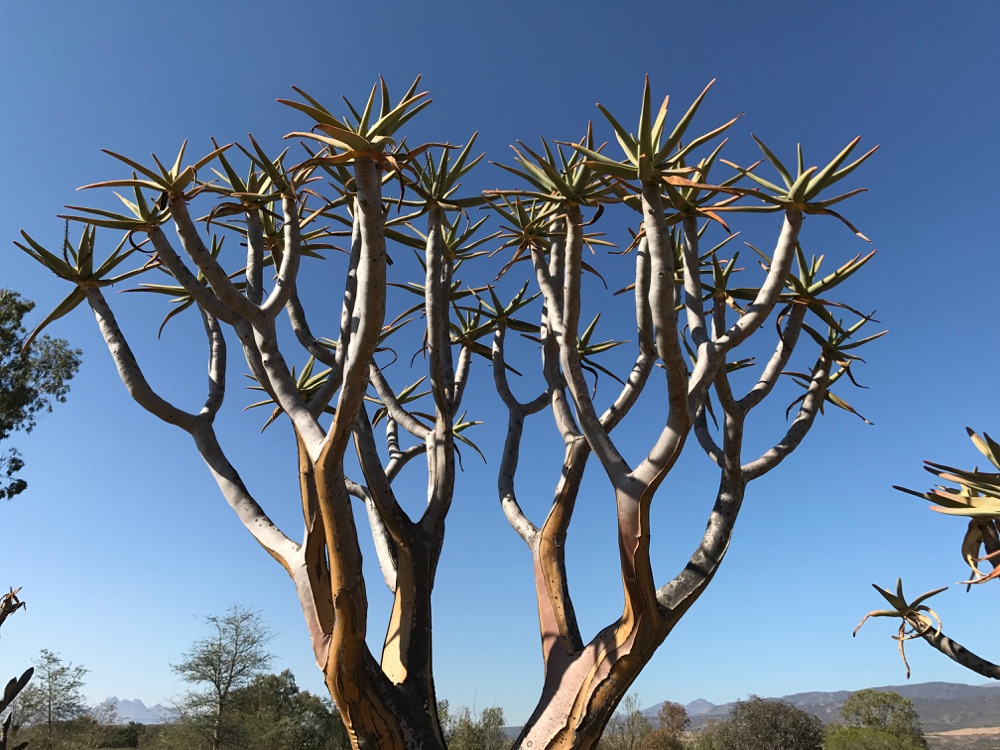
From Springbok, we made our way south to Clanwilliam, stopping on the way to see a magnificent display of quiver trees and other native African plants at the Kokerboom Nursery.
The nursery, now into its 60th year, specializes in succulents and other unusual items such as stone plants (lithops), but is the place where keen gardeners come to buy their quiver trees.

Kokerboom is located in Vanrhynsdorp, a typical early Afrikaans settlement with a Dutch Reform church at its hub.
When we arrived at the nursery, the first thing to catch our eye was a field full of quiver trees (Aloe dichotomy) with their distinctive yellow and white bark and canopies composed of attractive curls of fleshy, spiky branches.

The tree gets its common name from the San people who hollowed out the branches to use as quivers for their arrows.
The quiver trees are expensive. They are slow growing and are propagated from seed.
The nursery sells them for between $500 and $1,500 depending on size, taller ones selling for more.

Gardeners in Africa are shopping more and more for drought tolerant plants as the weather cycles change. The quiver tree and exotic succulents are gaining popularity and nurseries like Kokerboom are in more demand for their exciting plants.

As well as lovely aloes, some of which were in full bloom, we also got to see stone plants being propagated in an area covered with shade cloth, mainly to reduce the need for watering rather than to protect plants from sunlight.
In another spot, we were delighted to get close to a Botswana moringa tree with a striking white trunk.

On our way down from Springbok, we stopped at the Klawer Winery where we had a grand time tasting all the wines.
Now, the fun part of this is that not only were the wines very inexpensive – three top labels for under $10 – but also the way the winery did the wine tasting.

They put out bottles of all their best wines and just invited us to pick up a glass and pour ourselves a taste.
Well, you can imagine the size of the pours. Nobody was doing measly pours.
And pretty much all of us got to taste at least five or six wines. It was great fun. We all piled back on the bus a lot happier than when we got off it.

In Clanwilliam, we popped into the Ramskop flower garden where we found more exquisite examples of quiver trees.
Against a clear blue sky, the whirl of branches of the quiver trees looks phenomenal, a masterpiece worthy of any art gallery.

We wandered around the arid flower garden and were surprised and delighted to find lovely drifts of actotis as well as striking stands of watsonia and wonderful purple flowers of polygala, which also looked sensational held against the backdrop of a pure blue sky.

Just down the road, we stop at a local shoe factory and also wandered into the Rooibos Teahouse. Clanwilliam is the mecca of rooibos production.

The word means “red bush” and it is made from the tips of restio-like shrubs growing in the fynbos. As you move around, we see large fields neatly set out with rooibos plants to create lovely patterns.

In the afternoon, we drove over to Lambert’s Bay to see the large Cape gannet colony on the waterfront next to the harbour.



















